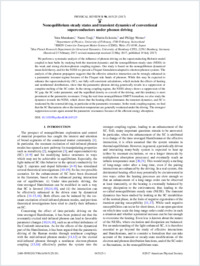Nonequilibrium steady states and transient dynamics of conventional superconductors under phonon driving
- Murakami, Yuta Department of Physics, University of Fribourg, Switzerland
- Tsuji, Naoto RIKEN Center for Emergent Matter Science (CEMS), Wako, Japan
- Eckstein, Martin Max Planck Research Department for Structural Dynamics, University of Hamburg, Germany
- Werner, Philipp Department of Physics, University of Fribourg, Switzerland
-
19.07.2017
Published in:
- Physical Review B. - 2017, vol. 96, no. 4, p. 045125
English
We perform a systematic analysis of the influence of phonon driving on the superconducting Holstein model coupled to heat baths by studying both the transient dynamics and the nonequilibrium steady state (NESS) in the weak and strong electron-phonon coupling regimes. Our study is based on the nonequilibrium dynamical mean-field theory, and for the NESS we present a Floquet formulation adapted to electron-phonon systems. The analysis of the phonon propagator suggests that the effective attractive interaction can be strongly enhanced in a parametric resonant regime because of the Floquet side bands of phonons. While this may be expected to enhance the superconductivity (SC), our fully self-consistent calculations, which include the effects of heating and nonthermal distributions, show that the parametric phonon driving generically results in a suppression or complete melting of the SC order. In the strong coupling regime, the NESS always shows a suppression of the SC gap, the SC order parameter, and the superfluid density as a result of the driving, and this tendency is most prominent at the parametric resonance. Using the real-time nonequilibrium DMFT formalism, we also study the dynamics towards the NESS, which shows that the heating effect dominates the transient dynamics, and SC is weakened by the external driving, in particular at the parametric resonance. In the weak coupling regime, we find that the SC fluctuations above the transition temperature are generally weakened under the driving. The strongest suppression occurs again around the parametric resonances because of the efficient energy absorption.
- Faculty
- Faculté des sciences et de médecine
- Department
- Département de Physique
- Language
-
- English
- Classification
- Physics
- License
- License undefined
- Identifiers
-
- RERO DOC 305134
- DOI 10.1103/PhysRevB.96.045125
- Persistent URL
- https://folia.unifr.ch/unifr/documents/305894
Statistics
Document views: 83
File downloads:
- wer_nss.pdf: 158
